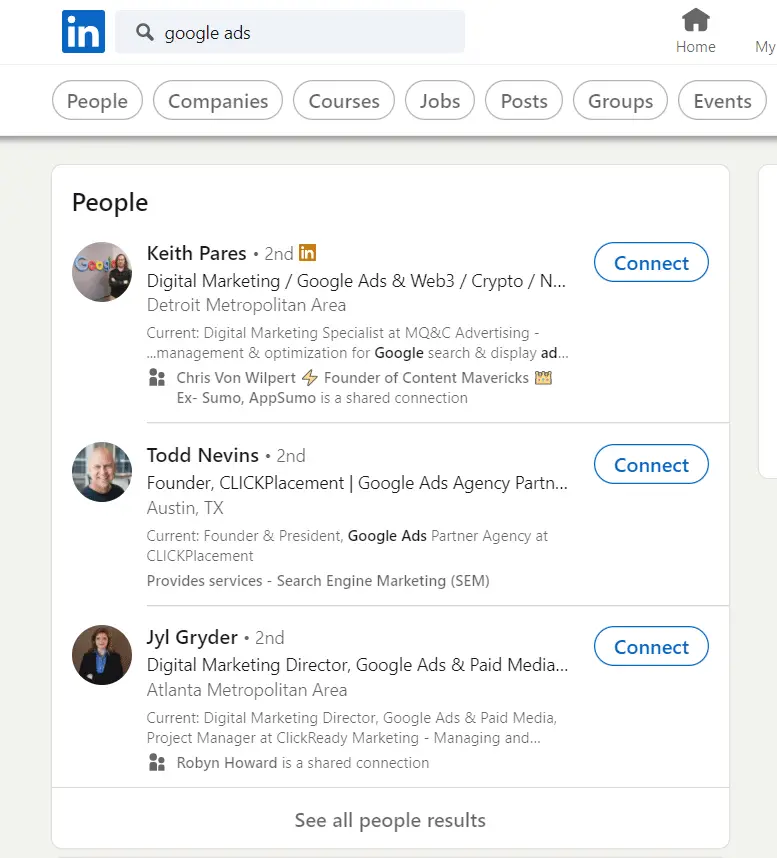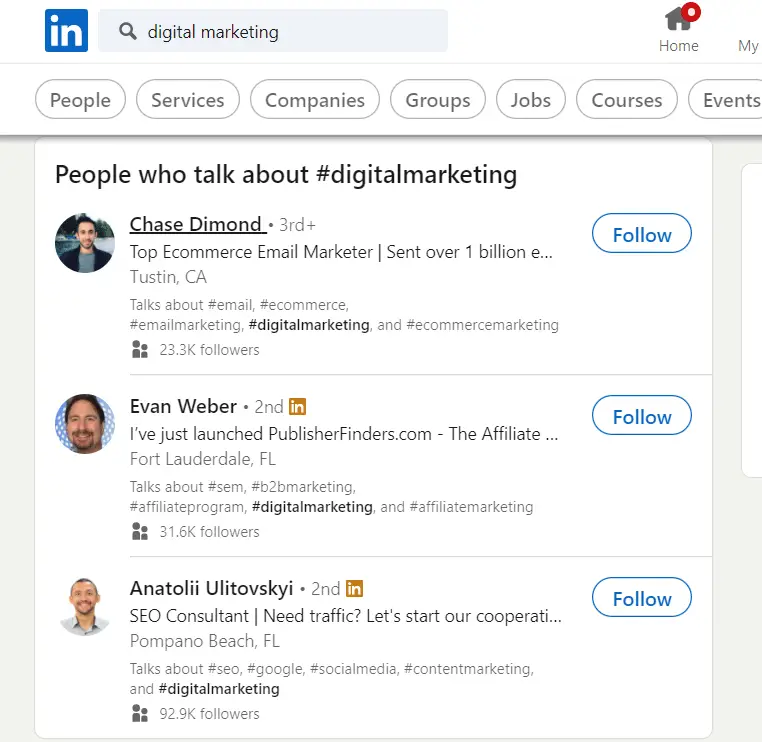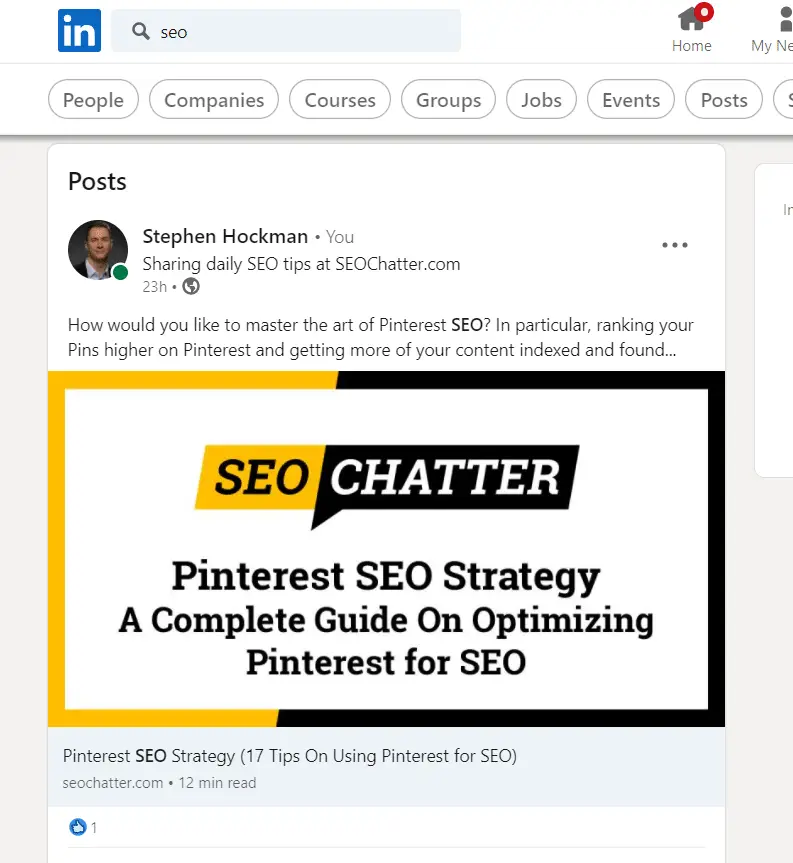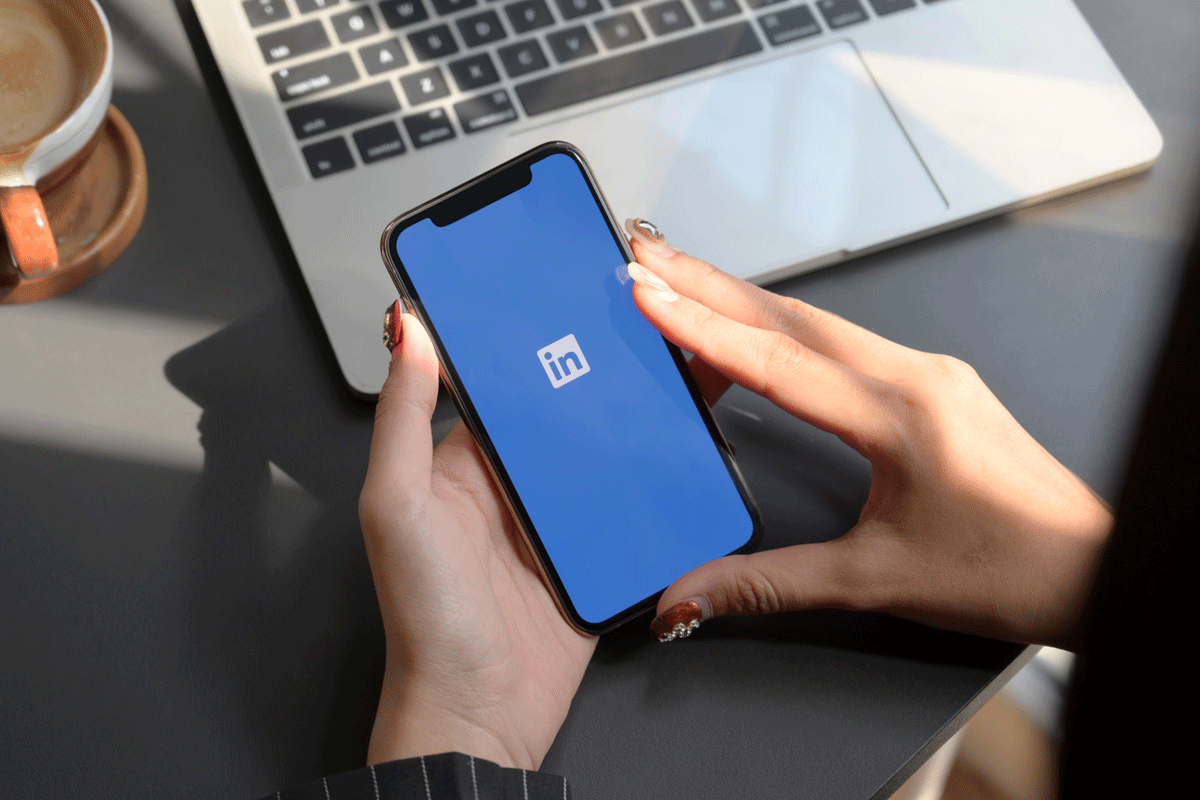This guide includes a complete LinkedIn SEO strategy you can use to help you optimize your profile and content to rank higher on the LinkedIn platform and in the search engine results pages (SERPs) on Google, Yahoo, and Bing for your target keywords.
The ultimate goal of this digital marketing guide is to give you a list of proven methods for search engine optimization to increase the visibility of your LinkedIn profile and content, build more quality backlinks to your website or blog, and create awareness for your brand where it counts most: on LinkedIn and in the search engines.
After you’re done reading this page, you’ll know the best ways for using LinkedIn for SEO to improve your website’s domain authority and page authority metrics as well as get your content found by more LinkedIn users on the platform.
What Is LinkedIn SEO?
LinkedIn SEO is the process of optimizing LinkedIn content to rank higher in the search engines and on the LinkedIn platform for more users to find relevant content. A good LinkedIn SEO strategy will increase visibility for your profile, content, and the number of quality backlinks to your website.
Is LinkedIn Good for SEO?
LinkedIn is good for SEO because LinkedIn helps you get more targeted website traffic and organic backlinks from other website owners. LinkedIn is also good for SEO because you can help the search engine algorithms understand your content so it can be ranked and indexed for its target keywords.
LinkedIn has a high domain authority and published content on the platform can rank in search engines like Google, Yahoo, and Bing to help your business capture more SERP visibility for its products and services. By using the combined power of SEO and LinkedIn, you can increase the number of people who find your content on the social media platform and through organic search queries.
LinkedIn SEO Strategy
1. Put SEO Keywords In Your LinkedIn Headline
The first step in your LinkedIn SEO strategy should always begin with adding keywords to your headline. (Also known as your job title.)
Optimizing the headline section of your LinkedIn profile is important because it helps your profile show up in LinkedIn’s search engine when people are looking for specific types of information. For example, if you type in “Google Ads” into the search bar, the following LinkedIn profiles will show up at the top of the results page because they have that keyword phrase in their headline.

LinkedIn allows 220 characters in your headline, so you should use every letter of it for SEO. Just make sure to put your most important keywords at the beginning of the headline section because they’ll carry the most weight for search engine optimization.
A good SEO practice for LinkedIn is to pick 3-5 keywords you want to optimize your profile extensively for. Then, make sure to use those same terms throughout the rest of the tips in strategy guide.
To edit your LinkedIn headline, just go to your profile, then click on the pencil icon in the introduction section. In the pop-up window, scroll down to “Headline” and insert your keywords there.
2. Create a Keyword-Rich Bio
The next step for doing SEO on LinkedIn is to optimize your “About” section. (Also known as the bio.) This will also help your profile rank higher in LinkedIn’s search engine as well getting your profile page indexed for keywords in Google, Yahoo, and Bing.
You have 2000 characters available to talk about who you are, what you do, and how you can bring value to other LinkedIn members on the platform while inserting your most important keywords throughout this section.
To edit your LinkedIn About section, just go to your profile, then click on the pencil icon next to the About section. In the pop-up window, add as much text as you like while also including your focus keywords.
3. Optimize Your Experience Section for SEO
Here’s another important strategy you should follow when using LinkedIn for SEO. In fact, it can help give your profile an edge in the LinkedIn search engine because most people have no idea how this works.
What you do is optimize your LinkedIn Experience section for SEO by adding your target keywords into the following places for each job you’ve held:
- Job Title
- Industry
- Description
And remember, the more jobs you have in your work history, the more opportunities you have to optimize the Experience section for relevant search queries.
4. Optimize Your Talks Abouts Section
This is a powerful LinkedIn SEO strategy you can use to help your profile show up at the top of the search results for both keyword and hashtag searches.
However, to unlock this optimization method you’ll need to turn on “Creator Mode” for your LinkedIn profile. To do that, follow these steps:
- Click the “Me” icon at the top of your LinkedIn homepage.
- Click “View Profile”.
- Scroll down to “Resources” and click on “Creator mode: Off”.
- Click “Next” on the Creator mode preview pop-up window.
- Add keywords as hashtags to indicate the topics you post about the most.
- Click “Done”.
After you’ve completed those steps, your profile will now include a “Talks About” section with the topics you included as hashtags. This will also improve the relevancy of your profile to help it appear more in LinkedIn’s search results for both the keyword phrases and hashtags.
Below is an example image of the LinkedIn profiles that are well-optimized for “digital marketing” by including that SEO keyword phrase as a hashtag in their “Talks About” section.

5. Add Context to Your Website URLs
The next step for getting the most out of your LinkedIn profile is to optimize your website URLs by giving them keyword context.
By default, most people choose “Personal”, “Company” or “Blog” in the dropdown field next to their website URLs. This results in generic text next to your link like “Company Website” rather than descriptive text with SEO keywords. However, if you choose “Other” in the dropdown field next to your URL, then you can customize the text that appears beside the link.
You can see how the un-optimized versus optimize URL description fields compare in the example image below. The first website URL has customized text with “SEO News and Tips” next to it because the “Other” option was selected in the dropdown field while the second URL has the generic “Company Website” text which appears by default for that type of selection.

To edit your LinkedIn website URLs text, follow these steps:
- Go to your profile.
- Click on the pencil icon in the introduction section.
- In the pop-up window, scroll to the bottom where it shows “Contact Info”.
- Click on “Edit Contact Info”.
- Add a website URL into the appropriate field.
- Click on the dropdown field next to the URL and choose “Other”.
- A new Type (Other) field will appear. Add your keywords here to add better context to the URL.
6. Customize Your LinkedIn URL
You can add some extra SEO value to your LinkedIn profile by customizing the URL to include your most important keyword.
When you optimize the URL for your profile, it will then look something like this: linkedin.com/in/yourkeyword.
To edit your LinkedIn URL, follow these steps:
- Click the “Me” icon at the top of your LinkedIn homepage.
- Click “View Profile”.
- Click “Edit Public Profile & URL” on the right side of the page.
- Under “Edit Your Custom URL” on the right side, click the “Edit” icon next to your public profile URL.
- Type or edit the last part of your new custom public profile URL in the text box.
- Click “Save” for the changes to take effect.
7. Create Backlinks to Your LinkedIn Profile
If you’re serious about using LinkedIn for SEO, then you’ll want to consider creating backlinks to your profile page.
By building quality links to your LinkedIn profile, the following things can happen:
- Your LinkedIn profile will increase ranking positions on Google, which can result in more views, endorsements, and user activity.
- The extra views and interactions on your profile will help increase your LinkedIn profile score for its internal ranking algorithm.
- Your LinkedIn profile will then rank higher on the social media platform for the keywords you’ve been optimizing for.
An easy way to get more backlinks to your profile page is to link to it from your website, blog, and through social media link building. You can also follow these guides on how to get quality backlinks and how to create backlinks for free to get more ideas on link building for LinkedIn.
8. Add Optimized Media to Your Profile
If you have media that’s located on other websites, then you can show off that content while also maximizing your SEO on LinkedIn.
First, you’ll want to add a new section to your profile for this optimized media. Go to your profile page, then click on “Add Profile Section” button that appears under your introduction. Next, choose “Featured” or “Projects” to add that section to the profile.
Now, when you’re adding media links to those news sections, make sure to also optimize the titles and descriptions for your target keywords.
9. Optimize Posts for SEO Keywords
Each time you add a new LinkedIn post on the platform, you have the opportunity to include keywords. And if you really want to show up in LinkedIn’s search engine for those phrases, then you need to create multiple posts that are optimized for those terms.
This SEO strategy is important for LinkedIn because each new post allows your content to show up in the search engine for relevant search queries. As you can see in the example image below, my LinkedIn posts show up a lot in the feed for the search query “SEO”. That’s because I make sure to use it every post I publish on the platform.

If you want to read the post featured above, go here: Pinterest SEO Strategy Guide.
10. Use Hashtags for More Views
Another way you can optimize your LinkedIn posts for SEO is to include relevant hashtags. This will also help your content get more views because some people actively search for posts on LinkedIn with hashtags.
The best practice here is to include 3-5 hashtags that repeat your target keywords. For example, when I publish a link to this guide on using LinkedIn for SEO, I’ll make sure to use these hashtags in the post:
- #seo
- #searchengineoptimization
- #linkedinmarketing
- #linkedintips
- #linkedinstrategy
11. Optimize Your Image ALT Text
Want to know a super simple way to rank your images higher on LinkedIn’s search engine?
Just add your keywords in the ALT text field after you upload them to a post.
The ALT text field is primarily for screen readers that help people with disabilities understand the context of the image. However, you can also add SEO keywords to this field to help the image rank for relevant searches. Just make sure to describe the image accurately while also inserting your relevant phrases.
Now, there are multiple ways to use LinkedIn for link building and tips #12-16 below will teach you how to create more backlinks from this platform. You also can read the full guide on building LinkedIn backlinks for SEO here.
12. Write SEO Optimized LinkedIn Articles
LinkedIn articles are a powerful way to share long-form content with your target audience and increase exposure for your brand with people who are not yet members of the network.
What makes LinkedIn articles so beneficial for digital marketing, SEO, and link building is that this content will be seen in the feeds of people who are connected to you on LinkedIn and through search engines like Google because these articles can get indexed and ranked in the SERPs for target keywords.
A good strategy here is to write an original LinkedIn article based on a topic that’s relevant to a web page on your site and optimize it for on-page SEO. That way, you can improve your chances of the article ranking in the top 10 positions on Google, Yahoo, and Bing and getting organic backlinks from other LinkedIn users who want to cite your content on their websites.
As for the length of your articles, you can write up to 125,000 characters (or 20,000 words) which gives you plenty of opportunity to showcase your expertise and knowledge on the topic and include several relevant backlinks to your website. Using contextual backlinks is also important here to help send important signals to the search engine algorithms about what keywords the target page should be ranked for.
Now, don’t feel pressured to max out the word count with this LinkedIn SEO strategy. A 1,000 to 3,000-word article is perfectly fine for a LinkedIn article and is actually the preferred length for most people’s reading tolerance.
To create backlinks to your website or blog in the article, just highlight the text you want to use for the link and insert the correct hyperlink. You can also insert standard URLs if you’re following a specific anchor text optimization ratio to achieve a more natural website backlink profile.
When you use LinkedIn articles the right way, you’ll not only increase the domain authority and page authority for your website as link equity gets passed through the backlinks on those articles to your website, but you’ll also drive more qualified traffic to your content by increasing visibility on the LinkedIn platform and in the search engines.
13. Repurpose Blog Posts On LinkedIn for Backlinks
If the previous tip got you excited about using SEO on LinkedIn, then this tip can help you speed up that process and/or give you an alternate way to create more backlinks to the same URLs.
One of the easiest ways you can combine LinkedIn and SEO with link building is to repurpose the existing content from your website or blog on the platform. In other words, copy and paste it into a LinkedIn article and add a backlink to the source URL at the end of the content.
A similar strategy is mentioned for the Medium platform, which can be read in this other guide on creating Medium backlinks for SEO. Give it a read if you’re interested in using Medium as another channel for off-page search engine optimization.
This content strategy is beneficial for two reasons:
- You can create multiple LinkedIn posts and articles from a single blog post and link them all back to your website.
- This increases exposure for your content to a new audience on LinkedIn and can generate high quality links from readers who visit your site and want to link to the full article from their own website or blog.
14. Build Backlinks To Your LinkedIn Articles
Similar to tip #7 above, you can help your LinkedIn articles rank higher in search engines like Google by building quality backlinks to the article URL.
The quality and number of backlinks a web page receives is a top-ranking factor for off-page optimization, and you can maximize the visibility of your LinkedIn articles on Google by creating good backlinks to them.
15. Post Backlinks In Replies to Other Posts
When you reply to other people’s posts on LinkedIn, you have the opportunity to include new links to your website or blog. This is a fast way to get more exposure for your content and increase the number of backlinks you have from LinkedIn.
However, you have to use this strategy with care so your comments don’t look like spam. Only post website links in the comments section when your content is relevant to the user’s post. Also, include a detailed response, opinion, or thoughtful comment so you’re adding value to the post.
Remember: LinkedIn is also used for brand awareness and you can easily ruin your brand’s reputation if you’re just dropping links on people’s posts without adding value to the conversation.
16. Identify Potential Link Partners on LinkedIn
LinkedIn is a great platform to find potential link partners to collaborate with for digital marketing purposes. By connecting with other bloggers and online marketers, you can create relationships in your industry that can lead to effective content collaborations.
To identify potential link partners on LinkedIn, simply search for people with businesses in your niche or who have job titles that relate to your target market. When you find someone who looks like a good potential partner, send them a connection request with a personal message to open the lines of communication.
After building up a relationship, you can then ask that person if they would link to a page on your website through a LinkedIn post or article to increase exposure for your brand to their professional network. You can also collaborate on guest posting in SEO and/or get editorial links added to an existing article along with a quote or testimonial.
17. Add More Skills
If the keywords you want to rank for on LinkedIn can also apply to work-related topics, then adding more skills to your profile can help you further optimize for those terms.
For example, on my LinkedIn profile, I added skills for “Search Engine Optimization”, “Link Building”, “Keyword Research”, “Content Marketing”, and other terms related to SEO and digital marketing.
To add skills to your profile, navigate to the “Skills” section and click on the + icon. In the pop-up window, you can type in keywords to add as new skills that appear on your page. After you’ve added those skills, you’ll then want to get endorsements in those areas as mentioned in the next tip.
18. Give and Receive Endorsements
LinkedIn endorsements are often overlooked as another valuable strategy for improving SEO on LinkedIn. However, endorsements give validation that you actually have the skills you claim to have in this section of your profile.
Plus, some experts believe that the more endorsement a skill has, the higher a profile can rank in the search engine for related keywords. LinkedIn’s algorithm tends to favor quantity metrics like this. Therefore, you should try to get other LinkedIn members to endorse you in the areas that matter most for your business.
You should also give out endorsements to other people you know on the platform. This makes it easier for others to reciprocate by endorsing your skills.
19. Build Smarter Connections
Another good practice for long-term LinkedIn success is to build connections with people on the platform who are within your industry. These individuals will be more receptive to the posts and articles you created on LinkedIn, which can lead to higher engagement, sharing, and organic backlinks if they decide to link back to your content from their websites.
20. Repeat These LinkedIn SEO Strategies for a Business Page
The final tip for combing SEO and LinkedIn is to create a business page if you haven’t done so already. Then, repeat as many of the strategies that apply above with that business page.
This method will allow you to double up on your optimization efforts when using the LinkedIn platform. For example, if you use tip #13 above on your personal LinkedIn account to repurpose a blog post with a backlink to your website, you can also repeat this strategy on your business page to get a second backlink without much effort.
This SEO tactic also allows you to capture more visibility in LinkedIn’s search engine because you end up with two articles that can be surfaced on the platform for relevant search queries. Plus, you have two new opportunities, not just one, to get your article content ranked in Google’s search engine for specific keyword phrases.
Summary for LinkedIn SEO & Profile Optimization Tips
I hope you enjoyed this guide on LinkedIn SEO.
As you discovered, a good LinkedIn SEO strategy can help in three primary ways: improving your chances of ranking for specific keywords on the platform, creating more high quality backlinks to your website, and increasing the number of pages that rank high on Google, Yahoo, and Bing for your target keywords to increase visibility for your business. By using LinkedIn for SEO the right way, you can penetrate more of the market with your content, achieve more referral website traffic, and get in front of the right target audience who can create more organic backlinks to your site from their own websites and blogs.

SEO Chatter is dedicated to teaching the fundamentals of search engine marketing to help marketers understand how to increase organic website traffic and improve search engine rankings.

